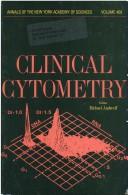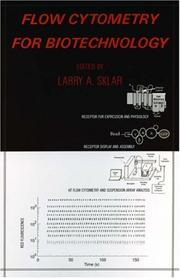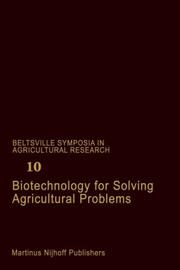| Listing 1 - 10 of 10 |
Sort by
|
Book
Year: 2016 Publisher: Bruxelles: UCL. Faculté de santé publique,
Abstract | Keywords | Export | Availability | Bookmark
 Loading...
Loading...Choose an application
- Reference Manager
- EndNote
- RefWorks (Direct export to RefWorks)
Le sujet a traité du manque de rentabilité des analyses d'immunophénotypage réalisées en cytométrie en flux au laboratoire d'hématologie du CHU Saint Pierre. L'objectif de ce mémoire est d'une part, de réaliser la description de la situation actuelle de la cytométrie via une analyse partielle des processus et des coûts engendrés par cette activité. Et d'autre part, de proposer des pistes d'amélioration de la gestion technique de la cytométrie. Pour atteindre cet objectif, une analyse de coûts partielle a été menée aux laboratoires d'hématologie du CHU Saint Pierre et l'hôpital Erasme. Dans un deuxième temps, ce mémoire a comparé les deux processus d'analyses d'immunophénotypage suivies dans les deux laboratoires hospitaliers visités. Ces démarches ont eu comme objectif, l'ambition d'améliorer l'efficience de l'activité de la cytométrie en flux du CHU Saint-Pierre. Méthodes : Les coûts des réactifs des 7 types d'analyses d'immunophénotypage, usuellement effectuées au laboratoire pour des patients ambulatoires en diagnostic, ont été décortiqués en coûts par test, par préparation de cocktail et par valorisation. Ces données furent comparées avec celle obtenues au laboratoire d'hématologie de l'hôpital Erasme. Les deux processus étudiés ont été décrits et sectionnés en 8 étapes. Les différences de pratiques y ont été situées. Résultats : Au CHU Saint Pierre, les résultats ont démontrés une variation de coûts entre les analyses effectuées en cytomètre SC et en cytomètre !OC. Les coûts par test d'imrnunophénotypage sont inférieurs à l'hôpital Erasme par rapport au CHU Saint Pierre. De plus, il existe des différences de pratiques de cytométrie en flux entre les deux laboratoires. Ce mémoire a permis l'élaboration de 5 pistes d'amélioration applicables au secteur de cytométrie du CHU Saint Pierre.
Flow Cytometry --- Hematology --- Neoplasms --- Immunophenotyping
Book
ISBN: 9782743012052 2743012056 Year: 2010 Publisher: Paris : Tec & Doc,
Abstract | Keywords | Export | Availability | Bookmark
 Loading...
Loading...Choose an application
- Reference Manager
- EndNote
- RefWorks (Direct export to RefWorks)
Cell Cycle --- Flow Cytometry --- Cell Cycle.
Book
Year: 2001 Publisher: Bruxelles: UCL,
Abstract | Keywords | Export | Availability | Bookmark
 Loading...
Loading...Choose an application
- Reference Manager
- EndNote
- RefWorks (Direct export to RefWorks)
The aim of this research is to study the immunophenotype of secreting lymphomas cells and especially of the Waldenstrom‘s Macroglobulinemia.
The secreting lymphomas, WM and lymphoplasmocytic lymphoma, are chronic B-cell lymphoproliferative disorders producing and secreting an IgM or IgG respectively
To characterize their immunophenotype, we compared WM cells with those of LPL to establish if there are specific surface markers between these two pathologies.
Then, we compared the immunophenotype if WM and LPL cells with this of normal B lymphocytes to evaluate which surface markers could be tested as sign of phenotypic disorder.
finally, to ameliorate the immunological differential diagnosis between secreting lymphomas and other chronic B-cell hemolymphopathies, the immunophenotype of WM and LPL cells has been compared with this of cells of other chronic B-cell lymphoproliferative syndromes, especially the chronic lymphocytic leukemia.
Because the samples were small and supposed to be “non-gaussien”, the Mann-Whitney test was chosen for comparison.
for the four comparisons realized, the statistics gave us different cell markers statistically significant at the 5% threshold. The markers were then evaluated for cytometric significance (difference > 5% or ≥ 50 CMF) and clinical significance (thresholds for abnormality).
The cell markers clinically significant are : - Comparison WM versus LPL : FMC7% and FMC7 IF
- Comparison WM et LPL versus normal B cells: CD25 % only with LPL, CD40 IF, CD54 IF, CD62L %, CD80 %, FMC7% only with WM, and IgD IF.
- Comparison WM and LPL versus LLC : CD5 % and IF, CD11a% and IF, CD18% and IF, CD20 % CD22% and IF, CD23 % and IF, CD25 %, CD38 %, CD43 %, CD54 IF, CD62L %, CD79a IF, CD79b IF, CD80 %, FMC7 % and IF, Ig κ/λ IF.
- Comparison WM and LPL versus other SPLC: CD54 IF, CD79b IF, CD80 %, FMC7 IF only with LPL, and Ig κ/λ IF.
In conclusion, only one marker is differently expressed on WM and LPL B cells. Some surface markers characterizing secreting lymphomas could be helpful for the differential diagnosis between lymphomas and other chronic lymphoproliferative syndromes Cette étude a pour but d’étudier l’immunophénotype des cellules des lymphomes sécrétants et en particulier de la Macroglobulinémie de Waldenström.
Les lymphomes sécrétants, WM et lymphome lymphoplasmocytaire, sont des hémolymphopathies malignes B produisant et sécrétant une IgM ou une IgG respectivement.
Pour caractériser les immunophénotype, nous avons comparé les cellules de WM avec les cellules de LPL de manière à déterminer s’il existe des marqueurs de surface spécifiques entre ces deux pathologies.
Ensuite, nous avons comparé l’immunophénotype des cellules de WM et LPL avec celui des lymphocytes B normaux afin d’évaluer quels marqueurs de surface peuvent être interprétés comme singes d’une anomalie phénotypique.
Enfin, pour faciliter le diagnostic différentiel entre les lymphomes sécrétants et les autres hémolymphopathies chroniques B, l’immunophénotype des cellules de WM et LPL a été comparé à celui des cellules des autres syndromes lymphoprolifératifs chroniques B et en particulier avec les cellules des leucémies lymphoïdes chroniques.
Ayant des petits échantillons dont au moins un des deux est non gaussien, la statistique utilisée pour réaliser les comparaisons est le test de Mann-Whitney.
pour chacune des quatre comparaisons faites, la statistique nous a fourni différents marqueurs de surface statistiquement significatifs au seuil α de 5%. Tous ces marqueurs ont alors été évalués pour définir quels sont ceux qui ont une signification cytométrique (différence > 5% ou ≥ 50 canaux médians d’intensité de fluorescence) et une signification clinique (par rapport à des valeurs de référence déterminant des critères d’anomalies phénotypiques).
Les marqueurs cliniquement significatifs sont :
- Comparaison WM versus LPL : FMC7% et FMC7 IF
- Comparaison WM et LPL versus cellules B normales : CD25 % uniquement avec LPL, CD40 IF, CD54 IF, CD62L %, CD80 %, FMC7% uniquement avec WM, et IgD IF.
- Comparaison WM et LPL versus LLC : CD5 % et IF, CD11a% et IF, CD18% et IF, CD20 % CD22% et IF, CD23 % et IF, CD25 %, CD38 %, CD43 %, CD54 IF, CD62L %, CD79a IF, CD79b IF, CD80 %, FMC7 % et IF, Ig κ/λ IF.
- Comparaison WM et LPL versus autres SPLC : CD54 IF, CD79b IF, CD80 %, FMC7 IF uniquement avec LPL, et Ig κ/λ IF.
Ceci nous permet de conclure qu’entre la WM et le LPL, seul le marqueur FMC7 montre une expression significativement différente. Certains marqueurs de membrane caractérisant les lymphomes sécrétants leur confèrent des anomalies phénotypes et peuvent ainsi améliorer le diagnostic différentiel entre les lymphomes sécrétants et les autres syndromes lymphoprolifératifs chroniques B
Flow Cytometry --- Lymphoma, B-Cell --- Waldenström Macroglobulimenia

ISBN: 0897663314 0897663322 9780897663328 Year: 1986 Volume: 468 Publisher: New York, N.Y. New York Academy of Sciences
Abstract | Keywords | Export | Availability | Bookmark
 Loading...
Loading...Choose an application
- Reference Manager
- EndNote
- RefWorks (Direct export to RefWorks)
Biological techniques --- Histology. Cytology --- Oncology. Neoplasms --- Semiology. Diagnosis. Symptomatology --- Flow Cytometry --- Flow cytometry --- Cancer cells --- Diagnostic use --- Congresses --- Identification --- Congresses. --- congresses. --- Flow Cytometry - congresses --- Flow cytometry - Diagnostic use - Congresses --- Cancer cells - Identification - Congresses --- Flow cytometry - Congresses

ISBN: 0195152344 9780195152340 Year: 2005 Publisher: Oxford Oxford University Press
Abstract | Keywords | Export | Availability | Bookmark
 Loading...
Loading...Choose an application
- Reference Manager
- EndNote
- RefWorks (Direct export to RefWorks)
Flow cytometry is a sensitive and quantitative platform for the measurement of particle fluorescence. In flow cytometry, the particles in a sample flow in single file through a focused laser beam at rates of hundreds to thousands of particles per second. During the time each particle is in the laser beam, on the order of ten microseconds, one or more fluorescent dyes associated with that particle are excited. The fluorescence emitted from each particle is collected through a microscope objective, spectrally filtered, and detected with photomultiplier tubes. Flow cytometry is uniquely capable of the precise and quantitative molecular analysis of genomic sequence information, interactions between purified biomolecules and cellular function. Combined with automated sample handling for increased sample throughput, these features make flow cytometry a versatile platform with applications at many stages of drug discovery. Traditionally, the particles studied are cells, especially blood cells; flow cytometry is used extensively in immunology. This volume shows how flow cytometry is integrated into modern biotechnology, dealing with issues of throughput, content, sensitivity, and high throughput informatics with applications in genomics, proteomics and protein-protein interactions, drug discovery, vaccine development, plant and reproductive biology, pharmacology and toxicology, cell-cell interactions and protein engineering.
Biotechnology --- Biotechnology. --- Flow Cytometry --- Flow cytometry. --- methods. --- kwantitatieve analyse (chemie) --- Toxicology --- biotechnologie --- toxicologie --- flowcytometrie --- Flow cytometry --- methods --- farmacologie --- genomics --- moleculaire biologie --- proteomics --- vaccinatie --- Methods. --- Flow Cytometry - methods --- Biotechnology - methods
Book
Year: 1993 Publisher: Liège: [éditeur inconnu],
Abstract | Keywords | Export | Availability | Bookmark
 Loading...
Loading...Choose an application
- Reference Manager
- EndNote
- RefWorks (Direct export to RefWorks)
Flow Cytometry --- Neoplasms, Radiation-Induced --- Lymphoma --- Tumor Necrosis Factor
Book
Publisher: Bruxelles: UCL,
Abstract | Keywords | Export | Availability | Bookmark
 Loading...
Loading...Choose an application
- Reference Manager
- EndNote
- RefWorks (Direct export to RefWorks)
In clinical practice, the ability to identify the presence of an abnormality on a blood smear is an important reliability determinant of a differential counting method. The clinical impact of a wrong differential count can be significant, which necessitates the presence of highly trained personnel for the microscopic review of the blood smears. However, interobserver and intraobserver variations in microscopy lead to difficulties in maintaining consistency in interpretation when rare events occur (generally less or equal to 2 % variation in the differential counts). Previously, studies employing automated image analysis systems dedicated to preclassifying the various types of WBC in peripheral blood smears, were performed in comparison with optical microscopy. In this work, we compare the results of final results obtained after morphological reclassification of cells by an expert technician in morphology using a digitizing microscope, the HemaCAM® system (n= 200 cells evaluated) with those obtained by optical microscopy (n=400 cells counted by two independant technologists) but also with those obtained by flow cytometry (FCM), considered as the reference method (“gold standard”), for blasts and lymphomatous ceils. In our comparison, we focused on 41 patients suffering from haematological neoplasias. We assessed the capability of the HemaCAM®, operating by a technician to classify accurately leukocytes and to detect abnormal circulating ceils (blast ceils, lymphomatous cells, immature myeloid ceils, plasma cells and NRBC). Blast cells and lymphomatous ceils were compared using the four methods (presence of flags on haematological analyzer, optical microscopy, HemaCAM® and flow cytometry). Increased sensibility and specificity to detect ail of these ceils, behalve NRBC, were demonstrated using HemaCAM in comparison with optical microscopy. The FCM permits to identify misclassification of blasts, lymphomatous ceils and atypical lymphocytes in acute leukemias and lymphomas. In combination with the HemaCAM system, the FCM allows morphological learning on objective bases. Increased accuracy of the differential count and recognition of qualitative abnormalities are the two major advantages of the HemaCAM system. Time sparing, conservation of cell images for each patient, education are the three other advantages of the HemaCAM system
Blood Cells --- Hematopoietic System --- Lymphoid Tissue --- Microscopy --- Flow Cytometry
Book
Year: 2011 Publisher: Bruxelles: UCL,
Abstract | Keywords | Export | Availability | Bookmark
 Loading...
Loading...Choose an application
- Reference Manager
- EndNote
- RefWorks (Direct export to RefWorks)
Les biopsies ganglionnaires sont des échantillons précieux qui ne sont pas rares dans les laboratoires d’hématologie. Vu leur importance diagnostique, il est nécessaire de développer au mieux les techniques disponibles dans un laboratoire spécialisé afin d’améliorer la précision dans le diagnostique ainsi que le temps de réponse de l’analyse. La cytologie sur empreinte, technique courante de première intention, apporte une information importante sur la morphologie cellulaire des différents éléments qui la composent mais pas sur sa structure. Cependant, sa lecture n’est pas des plu simple, l’observateur doit présenter une certaine expérience dans ce domaine. De plus, l’empreinte devra libérer de son suc les cellules d’intérêt qui permettront de poser le diagnostic. A côté de cette technique, nous aurons l’histologie réservée à l’anatomie pathologique, la cytogénétique ainsi que la biologie moléculaire. Elles donneront le diagnostic définitif mais dans un délai beaucoup plus long. C’est donc à la demande des cliniciens que nous avons développé en cytométrie en flux une technique en trois tubes permettant d’orienter et d’améliorer le diagnostic à partir des différents matériels de biopsie ou d’aspiration à l’aiguille fine. Le but premier de cette méthode est de permettre de faire la différence entre ganglion bénin ou malin ainsi que de diagnostiquer le type de pathologie ganglionnaire : lymphomes hodgkinien ou non-hodgkiniens, métastases d’une carcinome et autres
Sentinel Lymph Node Biopsy --- Cell Biology --- Ganglion Cysts --- Image Cytometry
Book
ISBN: 2746245299 9782746245297 Year: 2013 Publisher: Paris: Hermès,
Abstract | Keywords | Export | Availability | Bookmark
 Loading...
Loading...Choose an application
- Reference Manager
- EndNote
- RefWorks (Direct export to RefWorks)
Présentation de l'éditeur : "Les instruments jouent un rôle primordial dans l'avancée scientifique et technologique. Les ouvrages de cette mini-série consacrée à l'optique dans les instruments ont pour but de montrer que l'optique et les composants optiques constituent souvent la partie essentielle autour de laquelle interviennent l'électronique, la mécanique et l'informatique. Le premier tome a décrit les bases nécessaires à la compréhension des phénomènes physiques mis en jeu. Ce second tome a pour but d'illustrer par divers exemples le rôle fondamental de l'optique dans l'instrumentation destinée à la biologie et à la médecine. Sont développés quelques instruments utilisés en routine pour l'analyse et la caractérisation, des instruments de très haute complexité permettant aux chercheurs d'avoir accès à des mesures ultra précises ainsi que des technologies prometteuses actuellement en développement. Enfin ces exemples permettront de voir l'impact des lasers non seulement dans l'instrumentation mais aussi dans les soins médicaux depuis l'ophtalmologie jusqu'à la chirurgie et le traitement de nombreuses maladies."
Optical Devices --- Microscopy, Confocal --- Microscopy --- Flow Cytometry --- Tomography, Optical Coherence --- Laser Therapy

ISBN: 9024733111 9401084556 9400943962 9789024733118 Year: 1986 Volume: 10 Publisher: Dordrecht : Martinus Nijhoff Publishers,
Abstract | Keywords | Export | Availability | Bookmark
 Loading...
Loading...Choose an application
- Reference Manager
- EndNote
- RefWorks (Direct export to RefWorks)
The Annual Beltsville Symposium provides a forum for interaction among scientists involved in research that has vital impact on agriculture and on the agricultural sciences. The 10th Symposium in the series, Biotechnology for Solving Agricultural Problems, focuses on the use of a revolutionary new set of tools, biotechnology, and attempts to define the set in terms of its applications in agriculture. Biotechnology has already contributed to the genetic improvement of agricultural products. Procedures that were impossible to test or to implement in the past because of technological limitations are now routinely used by many scientists. Four areas that have benefitted from advances in biotechnology are covered in the symposium proceedings. These areas include genetic manipulation, nutrition, health and disease, and natural resource management. The 31 invited speakers have identified programs of basic and applied research on plants, animals, and insects that fall within these broad areas. Their research strategies included such techniques as germline modification, gene mapping, monoclonal antibody production, and gene transposition. These strategies have tapped new well springs of information and technologies ranging from the regulation of gene expression (and with it, the regulation of development, growth, disease resistance, and nutrient metabolism) to degradation of pesticides and toxic wastes. The applications of biotechnology to agricultural research have opened virgin vistas with enormous potential. The new biotechnological techniques and those that will evolve with their use will contribute markedly to the capacity of the agricultural sciences to advance the well-being of the human race.
$ Flow cytometry applied to spermatozoa sorting --- $ Female insect sterilizing genes --- $ Biological control of insects --- $ Herbicide resistance in crops --- $ Resistance improvement in plants --- $ Gene transfer --- $ Vaccinia virus vector --- $ Insect pest control --- $ Spermatozoa sorting by flow cytometry --- $ Hybridoma technology --- $ Gene mapping in domestic animals --- $ Recombinant DNA --- Agricultural biotechnology --- Agriculture --- Congresses --- Research --- $ African swine fever virus variation --- Congresses. --- Agricultural biotechnology - Congresses --- Agriculture - Research - Congresses --- Agricultural engineering.
| Listing 1 - 10 of 10 |
Sort by
|

 Search
Search Feedback
Feedback About UniCat
About UniCat  Help
Help News
News